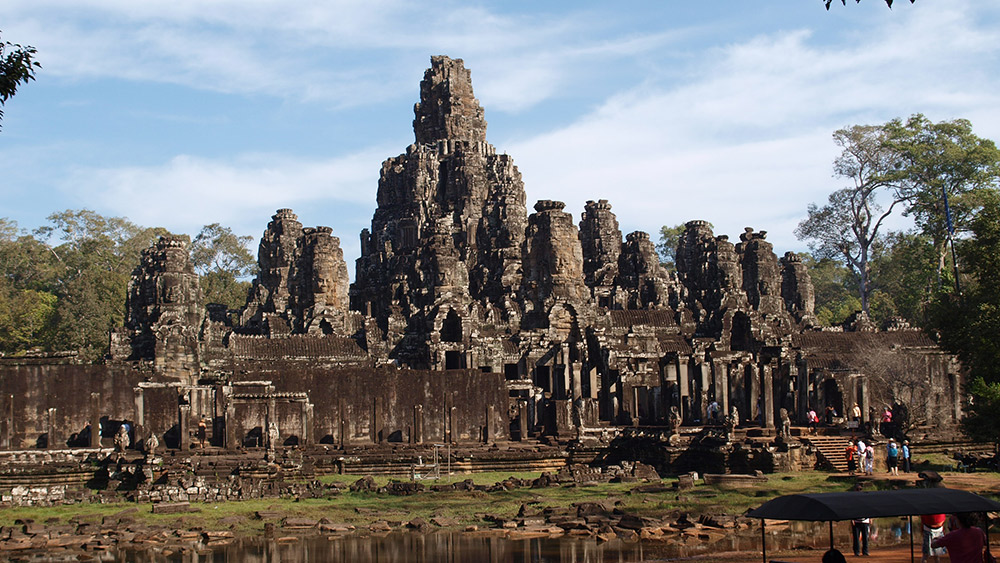As I got out of the tuk-tuk, the darkness that surrounded us didn’t seem quite so eerie. With the amount of people around my sister and I, you would never guess it was five in the morning. All of these people, just like us, were here to see one thing, Angkor Wat.
Everyone stood facing the same direction; what hid behind the darkness was the majestic temple that we had travelled to Siem Reap, Cambodia for. We waited for the sun to begin to rise and reveal the sandstone blocks with the outline of the immensely detailed lotus-bud towers. We stood in awe, and despite the hoards of people that surrounded us, all trying to get the best photo of the famed temple, nothing could take away from the beauty of Angkor Wat.

We waited for the sun to begin to rise and reveal the sandstone blocks. It was morning at Angkor Wat.
Angkor was the capital of the Khmer Empire, which flourished in the 9th to 15th centuries. A Khmer rebellion in 1431 caused the population of Angkor to migrate south to Longvek. Today, this archaeological park houses Angkor Wat, Cambodia’s most iconic temple, as well as the remains of several other monuments and temples.
The archaeological park itself stretches approximately 400sq km (154 sq mi)and is one of the most important archaeological sites of Southeast Asia. Visiting the grounds is definitely a must-do when travelling to Cambodia, but you’ll notice that it’s an ongoing disagreement between people on how much time you should allocate for your visit.
On my visit, we spent one day there, but we met people along our travels that were coming to the area from anywhere from a day to a week. This is entirely dependent on you and your interests, but I found one day to be enough to see what we wanted to see.
In our day at Angkor, we saw some five buildings, which included three of the most popular ones — Angkor Wat, Bayon, and Ta Prohm.

Young monks on the temple grounds.
Angkor Wat
The world’s largest religious building, a UNESCO World Heritage site, and a Wonder of the World, this is the temple that first comes to mind when people think of Cambodia or Angkor. Angkor Wat was constructed in the 12th century as a Hindu temple for the Khmer Empire and gradually transformed to a Buddhist temple. Since this is the best-preserved and largest temple in the park, it is the only one that has remained a significant religious centre.
Sunrise or sunset visits seem to be popular when visiting Angkor Wat, and expect that no matter how early or late you go, there will be a ton of people. A trick is to try to get a spot along the sides of the lake, this way it’ll be a bit more peaceful since everyone wants to stand in the centre. As soon as the sun rises, get yourself into the building. Many people will stand around waiting, and taking photos outside, which means that you’ll have the complex almost entirely to yourself until people begin to head in.

Wander into the temple for a quiet moment while everyone else is standing out front after sunrise.
Bayon
Although after visiting Angkor Wat, the other buildings on the premises won’t quite compare, Bayon is pretty impressive in its own way. This temple has 216 faces carved into it and holds carvings that hold combinations of mythological, historical, and mundane scenes and timelines.
Bayon was built in the late 12th, early 13th century as the official state temple of the Mahayana Buddhist King Jayavarman VII, and the similarity of the faces on the temple compared to other statues of the king has led many to believe that the 216 faces represent Jayavarman VII himself. Others say the faces belong to the bodhisattva of compassion, Avalokitesvara or Lokesvara.

Bayon temple landscape.
Ta Prohm
You may recognize this temple from the movies Tomb Raider and Indiana Jones, Ta Prohm doesn’t much resembles its friends Bayon and Angkor Wat, as the temple has been entirely left to the elements and is taken over by nature. This temple is in the same condition in which it was found and as you walk through it you may feel like you’re in a secret garden. Trees and their roots are growing from every which angle of the rubble, and its UNESCO World Heritage status has made it one of the most visited complexes in the region.
Jayavarman VII constructed Ta Prohm (then known as Rajavihara) in honour of his family, and records show that the site was once home to more than 12,500 people, with an additional 800,000 people in the surrounding villages who worked to provide services and supplies. After the fall of the Khmer Empire in the 17th century, Ta Prohm was abandoned and neglected. In the early 21st century when efforts were made to conserve and restore the temples of Angkor, it was decided to leave Ta Prohm largely as it had been found.

There's much more to Ta Prohm than what's been featured in the movies.
Visiting the temples of Angkor will be one of your highlights from any trip to Southeast Asia. It’s a site that will make you feel like you need to pinch yourself because it’s hard to believe a place so majestic exists in the world. Whether you’re in Cambodia for a day, or a year, make sure to take some time to give Angkor the visit it deserves.

A visit here will surely be a highlight of any trip.
Getting There
G Adventures runs a number of departures in Cambodia encompassing a wide range of departure dates and activities to cater to different tastes. We’re thrilled at the prospect of showing you this big blue planet of ours — check out our small group trips here.























